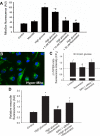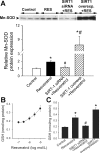Resveratrol attenuates mitochondrial oxidative stress in coronary arterial endothelial cells
- PMID: 19749157
- PMCID: PMC2781360
- DOI: 10.1152/ajpheart.00375.2009
Resveratrol attenuates mitochondrial oxidative stress in coronary arterial endothelial cells
Abstract
The production of hyperglycemia-induced mitochondrial reactive oxygen species (mtROS) is a key event in the development of diabetic complications. Because resveratrol, a naturally occurring polyphenol, has been reported to confer vasoprotection, improving endothelial function and preventing complications of diabetes, we investigated the effect of resveratrol on mtROS production in cultured human coronary arterial endothelial cells (CAECs). The measurement of MitoSox fluorescence showed that resveratrol attenuates both steady-state and high glucose (30 mM)-induced mtROS production in CAECs, an effect that was prevented by the knockdown of the protein deacetylase silent information regulator 2/sirtuin 1 (SIRT1), an intracellular target of resveratrol. An overexpression of SIRT1 mimicked the effects of resveratrol, attenuating mtROS production. Similar results were obtained in CAECs transfected with mitochondria-targeted H(2)O(2)-sensitive HyPer-Mito fluorescent sensor. Amplex red assay showed that resveratrol and SIRT1 overexpression significantly reduced cellular H(2)O(2) levels as well. Resveratrol upregulated MnSOD expression and increased cellular GSH content in a concentration-dependent manner (measured by HPLC coulometric analysis). These effects were attenuated by SIRT1 knockdown and mimicked by SIRT1 overexpression. We propose that resveratrol, via a pathway that involves the activation of SIRT1 and the upregulation of antioxidant defense mechanisms, attenuates mtROS production, suggesting the potential for new treatment approaches targeting endothelial mitochondria in metabolic diseases.
Figures



References
-
- Baur JA, Pearson KJ, Price NL, Jamieson HA, Lerin C, Kalra A, Prabhu VV, Allard JS, Lopez-Lluch G, Lewis K, Pistell PJ, Poosala S, Becker KG, Boss O, Gwinn D, Wang M, Ramaswamy S, Fishbein KW, Spencer RG, Lakatta EG, Le Couteur D, Shaw RJ, Navas P, Puigserver P, Ingram DK, de Cabo R, Sinclair DA. Resveratrol improves health and survival of mice on a high-calorie diet. Nature 444: 337–342, 2006 - PMC - PubMed
-
- Baur JA, Sinclair DA. Therapeutic potential of resveratrol: the in vivo evidence. Nat Rev Drug Discov 5: 493–506, 2006 - PubMed
-
- Belousov VV, Fradkov AF, Lukyanov KA, Staroverov DB, Shakhbazov KS, Terskikh AV, Lukyanov S. Genetically encoded fluorescent indicator for intracellular hydrogen peroxide. Nat Methods 3: 281–286, 2006 - PubMed
Publication types
MeSH terms
Substances
Grants and funding
LinkOut - more resources
Full Text Sources
Other Literature Sources
Medical

